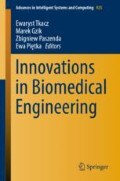Abstract
The aim of this work was an analysis of hyperelastic material models to predict the behavior of skin tissue. The most popular Mooney-Rivlin, Humprey, Veronda-Westmann, Yeoh and Ogden models were analized. The parallel and perpendicular to the pig’s spinal directions of specimens taken were consider in the tests. The input data to the simulation were defined for parallel direction as 5, 15, 25%, for perpendicular as 10, 20, 30, 40, 50% and also as total range of engineering stretch. The results were used to prediction of mechanical behavior and comparison with experimental and literature data. The strong influence of input data range on the values of model parameters was observed.
Access this chapter
Tax calculation will be finalised at checkout
Purchases are for personal use only
References
Benitez, J.M., Montans, F.J.: The mechanical behavior of skin: structures and models for the finite element analysis. Comput. Struct. 190, 75–107 (2017)
Chanda, A., Graeter, R., Unnikrishnan, V.: Effect of blasts on subject-specific computational models of skin and bone sections at various locations on the human body. AIMS Mater. Sci. 2(4), 425–447 (2015)
Flynn, C., Taberner, A., Nielsen, P.: Mechanical characterisation of in vivo human skin using a 3D force-sensitive micro-robot and finite element analysis. Biomech. Model. Mechanobiol. 10(1), 27–38 (2011)
Groves, R., Coulman, S., Birchall, J., Evans, S.: An anisotropic, hyperelastic model for skin: experimental measurements, finite element modelling and identification of parameters for human and murine skin. J. Mech. Behav. Biomed. Mater. 18, 167–180 (2013)
Joodaki, H., Panzer, M.B.: Skin mechanical properties and modeling: a review. Proc. Inst. Mech. Eng. Part H J. Eng. Med. 232(4), 323–343 (2018)
Lapeer, R.J., Gassona, D., Karri, V.: Simulating plastic surgery: from human skin tensile tests, through hyperelastic finite element models to real-time haptics. Prog. Biophys. Mol. Biol. 103(2–3), 208–216 (2010)
Liber-Kneć, A., Łagan, S.: Factors influencing on mechanical properties of porcine skin obtained in tensile test-preliminary studies. In: Advances in Intelligent Systems and Computing, vol. 623, pp. 255–262 (2018)
Lim, J., Hong, J., Chen, W.W., Weerasooriya, T.: Mechanical response of pig skin under dynamic tensile loading. Int. J. Impact Eng. 38, 130–135 (2011)
Łagan, S., Liber-Kneć, A.: Application of the Ogden model to the tensile stress-strain behavior of the pig’s. In: Advances in Intelligent Systems and Computing, vol. 526, pp. 145–152 (2017)
Łagan, S., Liber-Kneć, A.: Experimental testing and constitutive modeling of the mechanical properties of the swine skin tissue. Acta Bioeng. Biomech. 19(2), 93–102 (2017)
Łagan, S., Liber-Kneć, A.: Influence of strain rates on the hyperelastic material models parameters of pig skin tissue. In: Advances in Intelligent Systems and Computing, vol. 623, pp. 279–287 (2018)
Martins, P., Jorge, R.N., Ferreira, A.: A comparative study of several material models for prediction of hyperelastic properties: application to silicone-rubber and soft tissues. Strain 42, 135–147 (2006)
Ní Annaidh, A., Destrade, M., Gilchrist, M.D., Murphy, J.G.: Deficiencies in numerical models of anisotropic nonlinearly elastic materials. Biomech. Model. Mechanobiol. 12, 781–791 (2013)
Ottenio, M., Tran, D., Ní Annaidh, A., Gilchrist, M.D., Bruyère, K.: Strain rate and anisotropy effects on the tensile failure characteristics of human skin. J. Mech. Behav. Biomed. Mater. 41, 241–250 (2015)
Remache, D., Caliez, M., Gratton, M., Dos Santos, S.: The effects of cyclic tensile and stress-relaxation tests on porcine skin. J. Mech. Behav. Biomed. Mater. 77, 242–249 (2018)
Shergold, O.A., Fleck, N.A., Radford, D.: The uniaxial stress versus strain response of pig skin and silicone rubber at low and high strain rates. Int. J. Impact Eng. 32, 1384–1402 (2006)
Wex, C., Arndt, S., Stoll, A., Bruns, C., Kupriyanova, Y.: Isotropic incompressible hyperelastic models for modeling the mechanical behaviour of biological tissues: a review. BioMed Eng/Biomedizinische Technik 60(6), 577–592 (2015)
Acknowledgements
The work was realized due to statutory activities M-1/12/2018/DS.
Author information
Authors and Affiliations
Corresponding author
Editor information
Editors and Affiliations
Rights and permissions
Copyright information
© 2019 Springer Nature Switzerland AG
About this paper
Cite this paper
Łagan, S., Liber-Kneć, A. (2019). The Influence of Stretch Range on the Hyperelastic Material Model Parameters for Pig’s Skin with Consideration of Specimen Taken Direction. In: Tkacz, E., Gzik, M., Paszenda, Z., Piętka, E. (eds) Innovations in Biomedical Engineering. IBE 2018. Advances in Intelligent Systems and Computing, vol 925. Springer, Cham. https://doi.org/10.1007/978-3-030-15472-1_27
Download citation
DOI: https://doi.org/10.1007/978-3-030-15472-1_27
Published:
Publisher Name: Springer, Cham
Print ISBN: 978-3-030-15471-4
Online ISBN: 978-3-030-15472-1
eBook Packages: Intelligent Technologies and RoboticsIntelligent Technologies and Robotics (R0)

